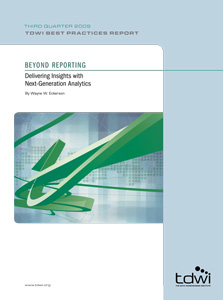
TDWI Best Practices Report | Beyond Reporting: Delivering Insights with Next-Generation Analytics
July 1, 2009
Webster’s Revised Unabridged Dictionary defines analytics as “the science of analysis,” and analysis as “the tracing of things to their source, and the resolving of knowledge into its original principles.” From a business perspective, these definitions imply that analytics is about understanding the root causes of business events and conditions. The upshot, of course, is that business people, armed with insights, will make the right decisions and take the appropriate actions to further their organizations’ tactical and strategic goals.
Unfortunately, analyzing data is not easy. First, finding people who have sufficient knowledge of the business processes, underlying data structures, and data access and analysis tools is challenging. Analytical literacy in most organizations is woefully lacking, and business analysts are a scarce commodity. Second, preparing and packaging organizational data so that business people can access and trust it is difficult, time-consuming, and expensive. Many companies want to reduce the time and cost required to clean, integrate, and load data for analysis, but there are few shortcuts here.
Third, today’s de facto analytical tools—spreadsheets, desktop databases, and reporting tools—are rudimentary at best and haven’t changed much in decades. Fortunately, there are many new analytical tools and technologies designed to improve the productivity of business analysts and preserve information consistency throughout an organization. These analytical tools and the types of users they are geared to are the focus of this report.